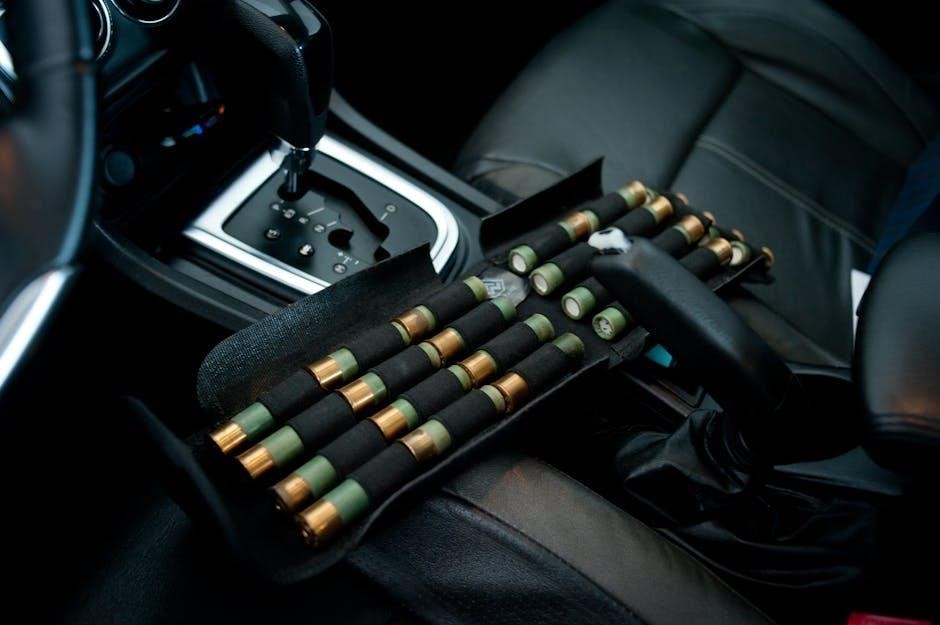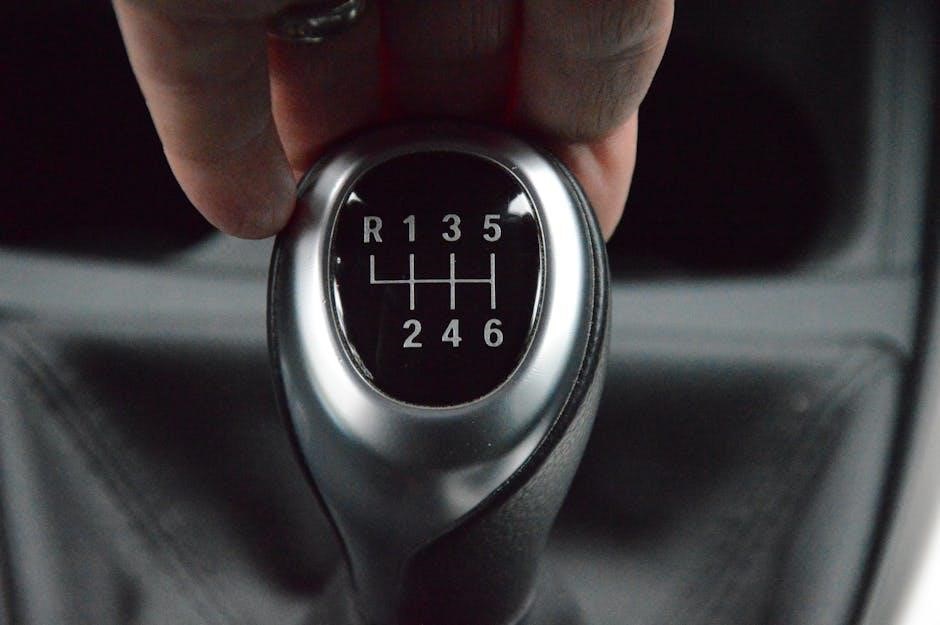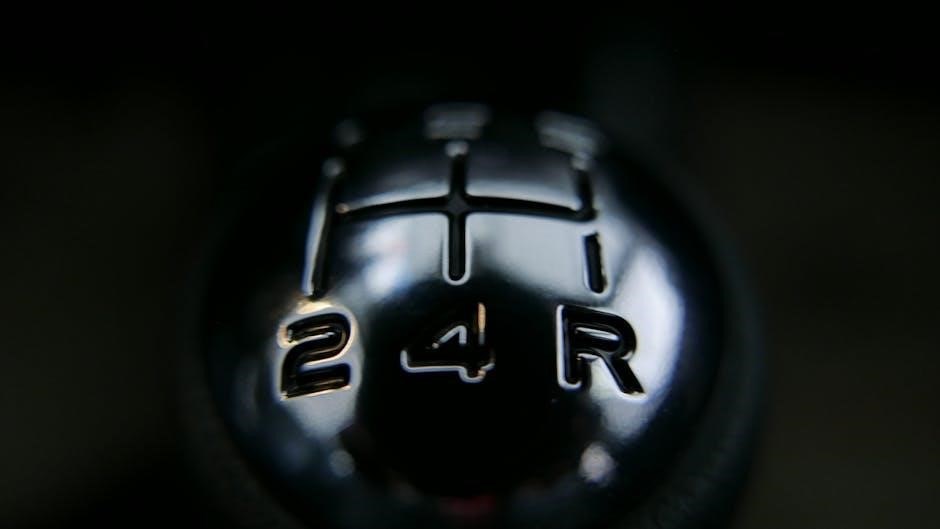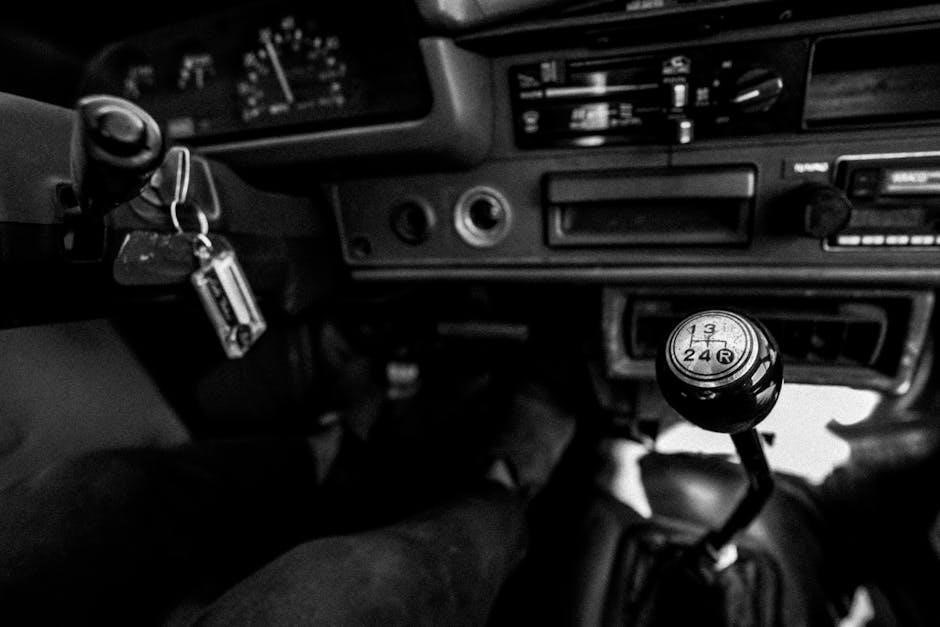Manual transmissions, known for reliability and fuel efficiency, can develop issues like oil leaks, slipping clutches, and gear problems, affecting performance and requiring timely maintenance.
Common Manual Transmission Problems
Common manual transmission problems include oil leaks, slipping clutches, gear shifting difficulties, and strange noises. These issues often stem from wear and tear, improper maintenance, or component failure, affecting overall performance.
Oil Leakage
Oil leakage is a prevalent issue in manual transmissions, often caused by worn seals, gaskets, or damaged components. Over time, seals degrade, allowing transmission fluid to escape, which can lead to reduced lubrication and increased wear on moving parts. In hydraulic clutches, leaks are common due to the system’s reliance on fluid pressure. Regular inspections and timely repairs are crucial to prevent further damage. If left unchecked, oil leakage can result in costly repairs, such as replacing entire transmission units. Modern manual transmissions, especially those with hydraulic systems, are more prone to leaks compared to older cable-operated models. Addressing leaks promptly ensures optimal performance and extends the lifespan of the transmission. Always consult a professional for accurate diagnosis and reliable fixes to maintain your vehicle’s health and safety on the road.
Slipping Clutch
A slipping clutch is a common issue in manual transmissions, often resulting from wear and tear. It occurs when the clutch fails to fully engage with the flywheel, causing the engine to lose connection with the transmission. This leads to reduced power transfer and potential damage to other components. Frequent city driving, aggressive acceleration, and improper clutch usage can accelerate wear. Symptoms include a spongy clutch pedal, difficulty shifting gears, and a noticeable decrease in vehicle performance. If ignored, a slipping clutch can damage the flywheel, pressure plate, and other critical parts, leading to costly repairs. Regular maintenance, such as adjusting or replacing worn clutch components, can prevent this issue. Additionally, avoiding excessive strain on the clutch, like riding the pedal, helps extend its lifespan and maintain smooth gear engagement.
Gear Shifting Problems
Gear shifting problems are a frequent issue in manual transmissions, often caused by worn-out synchronizers, hydraulic leaks, or improper clutch engagement. If the clutch doesn’t fully disengage, gears may grind or refuse to shift, leading to difficulty in accelerating or maintaining speed. Another common cause is a malfunctioning shift linkage, which can misalign gears and prevent proper engagement. Symptoms include a sticking gearshift, gears popping out of place, or a delay in shifting. Over time, this can damage the transmission’s internal components. Regular maintenance, such as replacing worn-out parts and ensuring proper lubrication, can help prevent these issues. Additionally, avoiding aggressive driving habits, like rapid shifting or riding the clutch, can extend the life of the transmission. Addressing gear shifting problems early is crucial to avoid costly repairs and ensure smooth, efficient driving performance;

Strange Noises
Strange noises from a manual transmission can signal underlying issues that need immediate attention. Common sounds include grinding, whining, or clunking, often linked to worn or damaged components. Grinding noises typically occur when gears don’t engage smoothly, possibly due to worn-out gear teeth or insufficient lubrication. Whining sounds may indicate faulty bearings or improperly aligned gears. Clunking noises could point to a loose drivetrain or broken mounts. These noises often worsen with speed or gear changes. Ignoring them can lead to more severe damage, such as gear failure or transmission breakdown. Regular lubrication checks and inspections of bearings and mounts can help identify and address these problems early. Consulting a professional mechanic is recommended to diagnose the root cause and prevent further deterioration of the transmission system. Addressing strange noises promptly ensures the longevity and optimal performance of the manual transmission.

Causes of Manual Transmission Issues

Lack of lubrication, improper clutch release, and worn-out parts are primary causes of manual transmission issues, often leading to premature wear and system failure if not addressed promptly.
Lack of Lubrication
Lack of lubrication is a significant cause of manual transmission issues. Transmission oil is essential for cooling and reducing friction between moving parts. Over time, low fluid levels or degraded oil can lead to increased wear on gears and synchronizers, causing shifting difficulties and noise. Hydraulic clutches, common in modern manual transmissions, are particularly vulnerable to fluid leaks, which can result in poor clutch engagement and slippage. Regular oil changes, typically recommended every 45,000 to 60,000 miles, help maintain proper lubrication and prevent premature wear. Using the wrong type of fluid or neglecting to replace it can exacerbate issues, leading to costly repairs; Consistent lubrication is critical to ensuring smooth operation and extending the lifespan of the transmission system.
Improper Clutch Release
Improper clutch release is another major cause of manual transmission issues. The clutch system relies on precise release to engage gears smoothly. If the clutch pedal is not fully disengaged or released quickly, it can cause excessive wear on the clutch disc and pressure plate. This often results in a slipping clutch, where the engine power fails to transfer effectively to the transmission. Incomplete release can also lead to difficulty shifting gears, especially in higher gears, and may cause the vehicle to jerk or stall. Hydraulic clutches are particularly sensitive to improper release, as it can lead to fluid pressure imbalances and cylinder damage. Regular inspection of the clutch mechanism and ensuring proper driving techniques are essential to prevent these issues. Ignoring improper clutch release can accelerate wear and require costly repairs, such as replacing the clutch assembly or related components.

Worn-Out Parts
Worn-out parts are a common cause of manual transmission issues, particularly in high-mileage vehicles. Over time, components like synchronizers, bearings, and gear teeth can degrade, leading to poor gear engagement and unexpected slipping. For instance, worn synchronizers can cause gears to clash or fail to engage properly, resulting in grinding sounds or difficulty shifting. Similarly, damaged bearings may produce loud noises or vibrations, while worn gear teeth can cause gears to slip out of place. Regular wear and tear, lack of lubrication, or aggressive driving habits can accelerate the deterioration of these parts. If left unchecked, worn-out components can lead to more severe damage, requiring expensive repairs or even a full transmission overhaul. To prevent this, it’s crucial to maintain proper lubrication and address any signs of wear promptly. Regular inspections can help identify and replace worn parts before they cause catastrophic failure. Early intervention is key to extending the life of the transmission.
Symptoms of a Failing Manual Transmission
Grinding sounds, difficulty engaging gears, and sudden jerking are common symptoms of a failing manual transmission. These issues often indicate worn-out parts or lubrication problems that need immediate attention.

Grinding Sounds

Grinding sounds when shifting gears are a clear indicator of a manual transmission issue. This noise typically arises from worn-out gear synchronizers or damaged dog teeth within the gearbox. When synchronizers fail, they cannot properly align gear speeds, leading to a grinding or clashing sound during shifts. Similarly, broken dog teeth, which lock gears into place, can cause gears to clash and produce the same unpleasant noise. If left unaddressed, this problem can escalate, causing further damage to the transmission. It is crucial to inspect and replace faulty components promptly to avoid costly repairs. Regular maintenance, such as checking transmission fluid levels and ensuring proper lubrication, can help prevent these issues from arising in the first place.
Difficulty Engaging Gears
Difficulty engaging gears is a common issue in manual transmissions, often caused by insufficient lubrication, worn-out synchronizers, or misaligned gear components. When transmission fluid levels are low or the wrong type of fluid is used, gears may not engage smoothly, leading to hesitation or failure to shift. Additionally, worn synchronizers can prevent gears from meshing properly, making it hard to engage them, especially when shifting into higher gears. In some cases, a faulty clutch or damaged gear teeth can also contribute to this problem; If left unaddressed, it can lead to further damage, such as chipped or broken gears. Regular maintenance, including fluid checks and inspections, can help prevent this issue. Addressing it early ensures smooth shifting and prolongs the transmission’s lifespan.
Sudden Jerking
Sudden jerking is a disconcerting issue that can occur in manual transmissions, often due to problems with the clutch or gear engagement. A faulty pilot bearing or damaged shift linkage can cause the transmission to jerk violently, especially when shifting gears. This issue may also arise from misaligned or worn-out components, such as the clutch disc or pressure plate, which fail to engage smoothly with the flywheel. In some cases, a malfunctioning clutch sensor or hydraulic system can lead to erratic behavior, resulting in sudden jerks. Drivers may notice this problem more prominently during acceleration or when shifting into lower gears. Ignoring this issue can lead to further damage, such as cracked gears or a damaged crankshaft. Regular inspections and timely repairs are essential to prevent costly complications and ensure smooth transmission operation.
